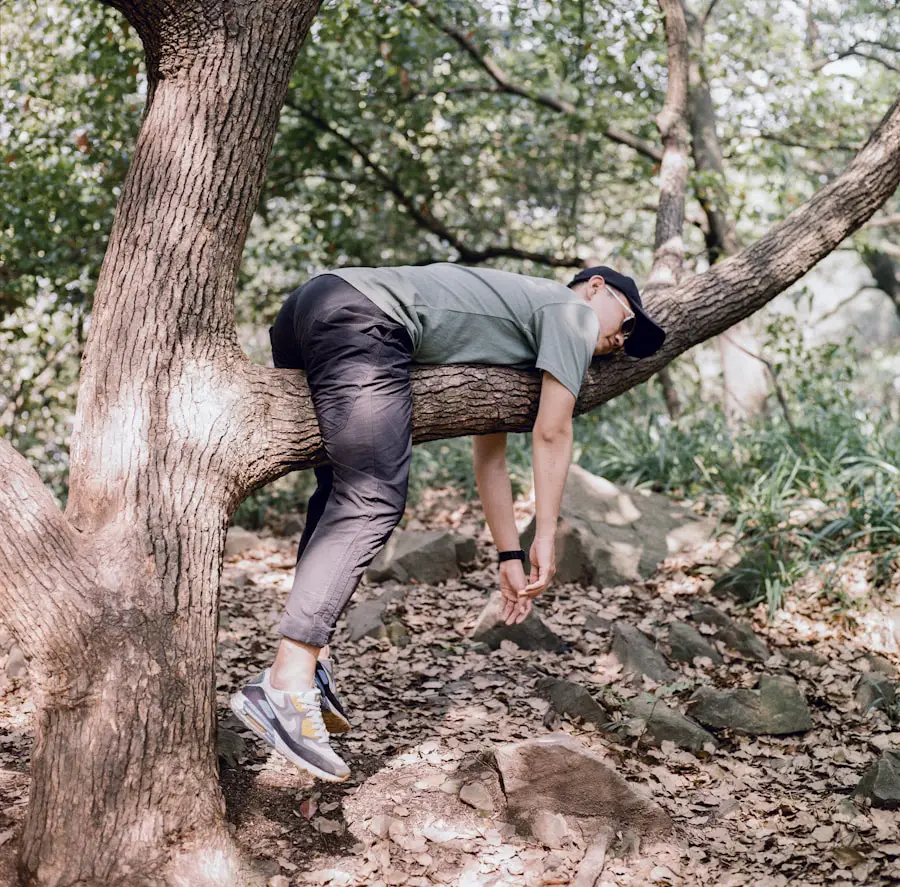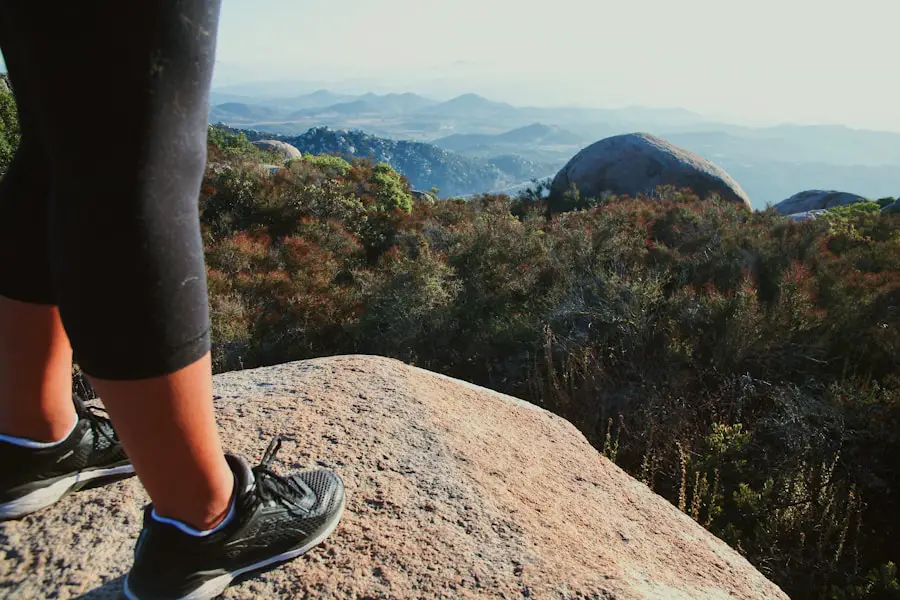Experiencing sore muscles after a hike is a common phenomenon that many outdoor enthusiasts encounter. This soreness, often referred to as delayed onset muscle soreness (DOMS), typically manifests 24 to 48 hours after engaging in physical activity, particularly if the body is not accustomed to the exertion. When hiking, the muscles undergo significant stress, especially during uphill climbs and descents, which can lead to microscopic tears in muscle fibers.
This process is a natural part of muscle adaptation and growth, but it can also result in discomfort that may deter individuals from pursuing further outdoor adventures. The intensity and duration of the hike play crucial roles in determining the severity of muscle soreness. For instance, a steep, rugged trail will engage different muscle groups more intensely than a flat, well-maintained path.
Additionally, factors such as the hiker’s fitness level, previous experience, and even the type of footwear can influence how sore one feels post-hike. Understanding these dynamics is essential for hikers to manage their expectations and prepare adequately for the physical demands of their chosen trails.
Key Takeaways
- Sore muscles after hiking are caused by microscopic damage to muscle fibers and inflammation
- Pre-hike preparation, including proper warm-up and stretching, can help prevent soreness
- Post-hike recovery techniques such as rest, hydration, and nutrition are essential for muscle recovery
- Hydration and nutrition play a crucial role in preventing and relieving sore muscles
- Hot and cold therapy can be used to reduce inflammation and relieve sore muscles
Pre-Hike Preparation to Prevent Soreness
To mitigate the risk of post-hike soreness, proper preparation before hitting the trails is paramount. One of the most effective strategies is to engage in a thorough warm-up routine that includes dynamic stretching and light aerobic activities. This approach increases blood flow to the muscles, enhances flexibility, and primes the body for the physical challenges ahead.
For example, performing leg swings, arm circles, and walking lunges can effectively prepare the major muscle groups used during hiking. In addition to warming up, selecting appropriate gear is crucial for preventing soreness. Wearing well-fitted hiking boots that provide adequate support can significantly reduce strain on the feet and lower legs.
Furthermore, choosing moisture-wicking clothing can help regulate body temperature and prevent chafing, which can distract from the hiking experience. It’s also wise to plan hikes that align with one’s fitness level; gradually increasing trail difficulty over time allows the body to adapt without overwhelming it.
Post-Hike Recovery Techniques

After completing a hike, implementing effective recovery techniques can significantly alleviate muscle soreness and promote healing. One of the most beneficial practices is engaging in gentle cool-down exercises. These may include walking at a slow pace for several minutes to gradually lower heart rate and prevent blood from pooling in the extremities.
Following this, static stretching can help lengthen tight muscles and improve flexibility. Focusing on major muscle groups such as the quadriceps, hamstrings, calves, and hip flexors can be particularly beneficial after a strenuous hike. Another essential aspect of post-hike recovery is incorporating rest into one’s routine.
Allowing time for muscles to recover is vital for preventing overuse injuries and ensuring that they are ready for future hikes. This might involve taking a day or two off from strenuous activities or engaging in low-impact exercises like swimming or cycling to maintain fitness levels without placing additional strain on sore muscles.
The Importance of Hydration and Nutrition
| Metrics | Hydration | Nutrition |
|---|---|---|
| Water intake recommendation | 8-10 cups per day for adults | Varies by age and gender, but generally 2.7-3.7 liters per day for adults |
| Impact on physical performance | Dehydration can lead to decreased endurance, strength, and coordination | Proper nutrition can improve muscle strength, endurance, and overall physical performance |
| Impact on cognitive function | Dehydration can impair cognitive function, concentration, and mood | Proper nutrition can enhance cognitive function, memory, and mood |
| Common signs of deficiency | Thirst, dry mouth, dark urine, fatigue, dizziness | Fatigue, weakness, dizziness, poor immune function, slow wound healing |
| Importance for overall health | Essential for regulating body temperature, transporting nutrients, and removing waste | Essential for growth, development, immune function, and disease prevention |
Hydration plays a critical role in muscle recovery and overall performance during hiking. When hiking, the body loses fluids through sweat, which can lead to dehydration if not adequately replenished. Dehydration can exacerbate muscle soreness and fatigue, making it essential for hikers to drink water before, during, and after their excursions.
A general guideline is to consume at least half a liter of water per hour of moderate activity; however, this may vary based on individual needs and environmental conditions. Nutrition also significantly impacts recovery from muscle soreness. Consuming a balanced meal or snack that includes carbohydrates and protein shortly after a hike can aid in muscle repair and replenish glycogen stores.
For instance, a combination of whole-grain bread with lean turkey or a smoothie made with fruits and yogurt can provide the necessary nutrients for recovery. Additionally, incorporating anti-inflammatory foods such as berries, nuts, and leafy greens into one’s diet can further support muscle healing and reduce soreness.
Using Hot and Cold Therapy for Muscle Relief
Hot and cold therapy are widely recognized methods for alleviating muscle soreness and promoting recovery after physical exertion. Cold therapy, often referred to as cryotherapy, involves applying ice packs or cold compresses to sore areas. This technique helps reduce inflammation and numbs sharp pain by constricting blood vessels and decreasing metabolic activity in the affected tissues.
For optimal results, cold therapy should be applied for 15-20 minutes at a time, especially within the first 48 hours post-hike when inflammation is typically at its peak. Conversely, heat therapy can be beneficial for relaxing tight muscles and improving blood flow to promote healing. Applying heat through warm towels or heating pads can soothe discomfort in sore areas after the initial inflammation has subsided.
Heat encourages vasodilation, which increases circulation and helps deliver essential nutrients to damaged tissues. Alternating between hot and cold treatments can also be effective; this contrast therapy stimulates circulation while providing relief from soreness.
Stretching and Yoga for Sore Muscle Relief

Stretching for Recovery
Stretching helps maintain flexibility and range of motion while reducing tension in tight muscles. Static stretches targeting key areas such as the hamstrings, quadriceps, calves, and back can be particularly effective when performed after hiking. Holding each stretch for 15-30 seconds allows muscles to relax and lengthen, promoting recovery.
The Benefits of Yoga
Yoga offers additional benefits beyond traditional stretching techniques. Many yoga poses focus on deep breathing and mindfulness, which can enhance relaxation and reduce stress levels—factors that contribute to muscle tension.
Targeted Yoga Poses
Poses such as Downward Dog, Child’s Pose, and Pigeon Pose specifically target areas commonly affected by hiking-related soreness. Regularly practicing yoga not only aids in recovery but also improves overall strength and balance, which can enhance hiking performance in the long run.
Massage and Foam Rolling for Muscle Recovery
Massage therapy is another effective method for relieving sore muscles after hiking. Professional massage therapists utilize various techniques to manipulate soft tissues, promoting relaxation and reducing muscle tension. Sports massages are particularly beneficial for athletes as they focus on specific muscle groups that may be overworked during physical activities like hiking.
Regular massage sessions can help prevent chronic soreness by improving circulation and facilitating faster recovery. For those who prefer self-care methods, foam rolling is an accessible alternative that can provide similar benefits to professional massage. Foam rollers are cylindrical tools designed to apply pressure to sore muscles through self-myofascial release techniques.
By rolling over tight areas, individuals can break up adhesions in muscle tissue and fascia, enhancing blood flow and reducing soreness. Targeting areas such as the thighs, calves, and back with a foam roller for several minutes can significantly alleviate discomfort after a long hike.
Rest and Recovery: Listening to Your Body
Ultimately, one of the most crucial aspects of managing post-hike soreness is learning to listen to one’s body. Each individual’s response to physical activity varies based on factors such as fitness level, age, and overall health. Recognizing signs of excessive fatigue or pain is essential; pushing through discomfort without allowing adequate recovery can lead to injuries or chronic issues down the line.
Incorporating rest days into one’s routine is vital for long-term success in hiking or any physical activity. These rest days allow muscles to repair themselves while preventing burnout or overtraining syndrome. Engaging in light activities such as walking or gentle stretching on rest days can help maintain mobility without placing additional strain on sore muscles.
By prioritizing rest and recovery alongside training efforts, hikers can enjoy their outdoor pursuits while minimizing discomfort associated with sore muscles after hiking adventures.
If you’re looking for ways to relieve sore muscles after a long hike, you may also be interested in finding the best sleeping bag for your backpacking adventures. Check out this article on
